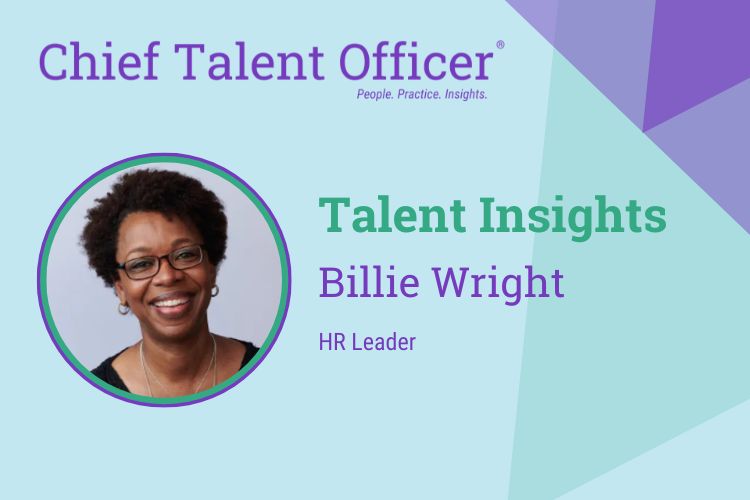Chief Talent Officer’s “Talent Insights” series is dedicated to sharing the insights and expertise of influential talent executives. In this Q&A series, we garner strategic insights, innovative approaches and challenges overcome from C-suite talent and HR executives, chief talent officers, chief people officers and more who are shaping the future of talent management.
What initially drew you to a career in talent management, and how have your experiences in the field evolved over the years?
I consider myself an accidental tourist when it comes to talent management! It found me, I did not find it. I worked in an organization that had an EVP of HR who just also happened to be a Black woman. She saw something in me that I didn’t see in myself. I always thought that I had to have a job and didn’t even think about the job becoming a career until I entered the field of HR. When I first entered this field I did everything – and to this day, still consider myself a true generalist at heart. What has changed now is the many variations of HR functions. Talent management encompasses so many HR functions from onboarding to recruiting and retention. However, in today’s talent management realm each function is segmented to some degree as a stand-alone entity.
What core values and principles do you believe are essential for building a positive and inclusive company culture?
Company culture is the combination of every employee’s values and beliefs paired with the example set by leadership. One could say that company culture is described as the worst behavior allowed by leadership. If you’re setting out to create a culture where everyone feels warm, wanted and welcomed then it starts at the top with modeled behavior and expectations. I firmly believe that a core value for every leader should be that everyone deserves to be treated with dignity and respect. As John C. Maxwell said best, “a leader without any followers is merely taking a walk.” If the core values and principles of an organization are not clearly defined and expected and the “why” behind them is not communicated, then employees won’t support it because they can’t see themselves in it nor do they have reason to believe in the values.
“If you put the interests of employees first – considering the impact to people as a result of the objective, it will almost always lead to better decision making.”
Can you share a significant challenge you’ve faced as a talent leader and how you successfully navigated through it?
One significant challenge I’ve faced in just about every leadership role I’ve had is leadership resistance to change. Organizations are quick to identify what they want to see happen when it comes to implementing culture and change strategies, but tell a very different story when they realize their role in the process. I’ve overcome this barrier by simply asking “why?” Why are they resistant? Do they understand the assignment? What can I do to support them through this process as well? I’ve found that leaders don’t like to admit they don’t know what they don’t know. That messaging downstream isn’t clear, expectations aren’t clear, goals and objectives aren’t clear, etc. I find it easy to just simply have a conversation and begin it with “why?”
What strategies have you found most effective in attracting and retaining top talent in competitive industries?
In today’s labor market there is a very clear war on talent. I have found that in order to attract and retain top talent you must do a lot of research on what motivates people, beginning with all things – the people. Exit interviews are fine, but it’s the stay interviews that will give you the details on what people want in addition to salary. Conducting stay interviews, pulse surveys with internal staff as well as applicants will provide excellent data on total reward strategies.
How do you balance advocating for employees’ needs while aligning with your company’s business objectives?
I am a servant leader who leads with a servant’s heart. If you put the interests of employees first – considering the impact to people as a result of the objective, it will almost always lead to better decision making. However, it’s hardly ever this easy, especially when there’s a business imperative or financial obligation. Sometimes “no” doesn’t mean “never,” but maybe “just not right now.” I have found that when you clearly lay out the impact to people against the business objective, there is always common ground to achieve both by eliminating the “either/or” and replacing it with “by doing/and.”
What leadership skills do you prioritize and cultivate as a senior talent leader to inspire your team and drive talent initiatives?
Listening, practicing patience and valuing my team members as people, not just employees.
What game-changing advice would you offer if you could go back in time and mentor your younger self?
Slow down! I’m a high performer and it took me a long time to realize that I was putting expectations on others based on the expectations that I had for myself.
What do you feel is currently the single biggest challenge facing talent professionals and the industry as a whole?
For me, it’s the same today as it was 10 years ago – having a strategic voice in the organization. Leadership doesn’t often fully understand the role and importance of talent management and how without it being properly supported and respected, everything is a hamster wheel. Same thing, different day, same results.
We’re always looking to showcase innovative tools and technologies. Can you share one tech product or platform that has significantly improved your work processes and why you find it valuable?
Lattice performance management system is an excellent tool for administering performance management and employee surveys. It has great data insights.
Interested in being featured in our “Talent Insights” series? Please complete this FORM.
















